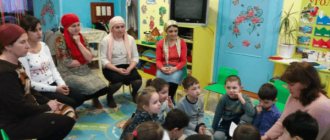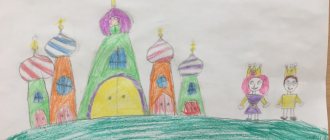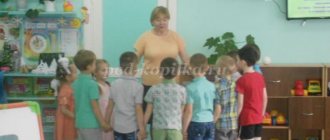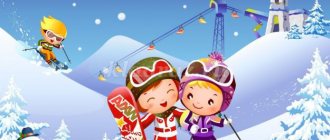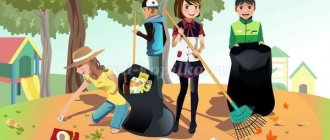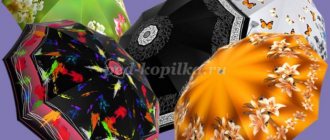Summary of NOD in the preparatory group “In the Land of Tolerance”
Summary of educational activities in the preparatory group
“In the Country of Tolerance”, educational area “Socialization”
Prepared by:
Kochetkova E.V.
Group:
preparatory
Program content: Purpose.
Continue to reinforce the idea that planet Earth is a home for all people to love.
Objectives:
To consolidate the idea of the individual characteristics of other people (children). To promote tolerance, respect and tolerance for people regardless of race, language, gender. Objectives: Continue the formation of communication abilities in children through the use of information and communication technologies (ICT) Strengthen the understanding of the individual characteristics of other people (children). To promote respect and tolerance for people regardless of their nationality, language, or religion.
Materials:
Screen, projector, flower with petals (with written words), proverbs, ball, stereo system
Progress of joint activities:
The teacher and the children enter the hall, the children stand in a circle and say the words I am your friend and you are my friend.
Let's hold hands together and smile at each other! (Hold hands and look at each other with a smile). Educator: The guys came to visit us today. Let's smile at the guests, say hello and get down to business. The teacher and children say the words: - Good afternoon! - We told you, - Good afternoon! -You said. How two strings were connected - Warmth and kindness. After the greeting, the children and teacher sit on chairs and the first slide with the poem appears. 1. SLIDE Ya. Akim There is one planet - a garden In this cold space Only here the forests are noisy, calling migrating birds. Only on it alone do lilies of the valley bloom in the green grass, and only here do dragonflies look into the river in surprise. Take care of your planet - After all, there is no other like it! Educator:
-What kind of planet is this that is mentioned in the poem?
Children's answers
. (The poem talks about our planet Earth).
Educator:
-Guys, who can see our planet in all its glory?
Children's answers
: -Cosmonauts.
Educator
: -Can you and I see our planet?
Children's answers. Educator
: -You and I can look at the model of the Earth.
Educator
: -Who can tell what it’s called?
Children's answers (The model of the earth is called a globe) (showing the globe) Educator
: - What can you see on it?
Children's answers: (you can see seas and oceans, continents on it) Educator
: -Who inhabits our planet?
Children's answers (people, animals, plants, etc.) Educator
: - Guys!
Today we will go on a journey through the “Land of Tolerance” Educator
- Tolerance.
What it is? Children's answers (good, kind attitude towards all people) Slide with a poem.
Tolerance.
What's happened? If anyone asks me, I will answer - this is everything earthly, That on which the entire planet stands. Tolerance is people of light, of different nations, faiths and destinies, discovering something, somewhere, rejoicing together. No need. Fear that you will be offended by People of the color of blood that is not yours, Fear that you will be humiliated by People in your native land. After all, our dear planet Loves all of us, white and colored. We will live, respecting each other, Tolerance is a word for the living. Educator
: - You know guys, so that people always remember these words and do good deeds, in many countries around the world the International Day of Tolerance is celebrated on November 16th.
Educator
: - I ask the girls to stand up.
Educator
: - Now please stand up, boys.
Educator
: - Please, guys, who has dark hair, and now who has blond hair, please stand up?
Educator
: - Think and say: “What are we all like?”
Children's answers (we are all different) Educator
: - Why are people different?
- How are we different? (shape of face, nose, cheeks, skin color, eyes, hair) Educator
: -Why are people from different countries so different from each other?
Children's answers (People live in different parts of the world). Educator
: -Do you know why this is so?
Let's look at the world map, did you answer correctly (Children look at pictures of people of different races on the slides) Q: - We are all different, but we are together, and we are all equal. Educator
: - Now let's remember the good qualities that you know in each other.
Let's stand in a circle and, passing the ball, we will name these qualities. Game “Compliments”
Q: - What do you think it means to be Tolerant?
Expected answers from children (to be kind, good) Educator
: - Guys, I brought you a flower of tolerance, but along the way it crumbled.
Can you help me assemble it? Game “Flower of Tolerance”
Petals with words are distributed (compassion, mercy, forgiveness, respect for human dignity, acceptance of others, kindness, anger, rudeness, fighting, cooperation, respect for the rights of others)
Educator
: - Look what words are written on the petals What petals are like you Do you think they suit our flower of tolerance?
Children choose those petals that match the flower. Educator
: - What do these words have in common?
Children's answers (these are good words) I attach the middle on which the word tolerance is written. Educator
: - And why don’t the remaining petals fit?
Children's answers. (These words are about bad deeds) Educator
: -Today we will go on a journey on a magic train.
Traveling through the Land of Tolerance, we will relax, play, and most importantly, learn to give people joy, be friendly, and attentive. The train signal sounds (children imitate the movement of the train). Educator
: - And there’s a city ahead. And to find out what it is called, you need to guess the riddle. Often you make it for people, and they make it for you. You have it in your soul, but you can’t find it anywhere. (Welcome)
Educator
:- So, what is the name of our first city?
(Dobro) And in the city of Dobro the first test awaits us, and if we are friendly and help each other, then we will cope with them. Educator
: - The main theme of fairy tales was and remains the struggle between good and evil.
I will name the fairy-tale hero, and you will answer what he is like. If you are kind, you clap your hands joyfully, and if you are evil, you stomp your feet. Ivan Tsarevich, Koschei the Immortal, Goldfish, Thumbelina, Karabas Barabas, Cinderella, Little Red Riding Hood, Geese-Swans, Merman, Baba Yaga, Morozko, Malvina. Educator
: - Guys, when people come to visit each other, or meet on the street, what do they say? Of course you need to say hello. Every well-mannered person should say hello. I want to tell you and show you how they greet each other in different countries.
Game "World Greetings" (slide show)
Russia – a hug and three kisses alternately on both cheeks.
China - light bow with arms crossed on the chest. France - handshake and kiss on both cheeks or Kiss, touching each other's cheeks alternately and sending one to five kisses into the air India - light bow, palms extended in front of the forehead. Japan - a slight bow, arms and palms extended at the sides Germany - a simple handshake and a look into the eyes. The Eskimo tradition is to rub noses against each other. Arabs - cross their arms over their chest; Samoans - sniff each other. Educator
: - And now, on command, when I say: “Hello,” you all say hello together in the way you like best.
Educator
: - Okay, we passed this test.
A signal sounds (children imitate the movement of a train) on the screen a slide with a train is replaced by a slide of the city of “Wise Men”
Educator:-
You and I found ourselves in the city of the Sages.
I will read the beginning of the proverbs, and you will continue it. •Good deeds make a person beautiful. • Hurry to do good. • Life is given for good deeds. • Good is paid for with good. Educator
: - Well done, you coped with this task!
Educator
: - And now, so that we can rest, we’ll do some physical education for the eyes.
Look at the screen and follow the insects with your eyes . (On the screen there are slides with a physical education lesson)
Well done, our eyes have had a rest, let's hit the road further!
A signal sounds (imitation of a train movement) on the screen, a slide with a train is replaced by a slide of the city “Good Deeds”
Educator
:- Attention city “Good Deeds” Guys, to complete this task you need to split into pairs.
Couples, sit down on the carpet! I will give each pair a picture that shows children committing intolerant (bad) acts. Discuss what the children are doing wrong and decide what to do!” Educator
: - Guys, you have completed this task!
Go ahead. A signal sounds (children imitate the movement of a train) on the screen a slide with a train is replaced by a slide of the city of “Magic Words.”
To
the teacher
: - We have arrived in the city of “Magic Words.”
We need to complete all the tasks in order to move on. Every polite and well-mannered person says words that we call “magic”. Guys, listen to the poem, guess, and tell me what “magic” word should be said. Game “Give me a word”
Even a block of ice will melt from a warm word... (Thank you) An old tree stump will turn green when it hears... (Good afternoon) The boy is polite and developed, he says, when meeting,... (Hello) When we are scolded for pranks, we say:... (Please forgive me) Both in France and Denmark they say goodbye when they say goodbye: ... (Goodbye)
Game “Please” Educator: -
I will give you various tasks, and you will have to complete them only if I The task is to say the word “Please”.
If this word is not there, do not complete the task. All clear? Let's try. Be very careful. Game "Please" • Please stand up. • Raise your right hand. • Please raise your left hand. • Kindly sit down. • Please clap. • Stomp. • Please smile! Educator
: - and we completed this task!
Forward! The song “Blue Car” plays (imitation of the movement of a train); on the screen, the slide of the train is replaced by the slide of the city “Zagadok”. Educator:
- Our journey continues, and we find ourselves in the city of “Riddles”. I will ask you riddles. If the riddle is about kindness and politeness, then in response to it you need to say in unison: “This is me, this is me, these are all my friends!” and clap. If the riddle is about what you can’t do, keep silent and drown. Game “This is me, this is me, these are all my friends!” Who among you, waking up cheerfully, will say good morning firmly? (Answer) Tell me, brothers, which of you forgets to wash your face? How many of you have your bag, books and notebooks in order? How many of you on a cramped tram give up a seat to older people? How many of you are silent like a fish instead of a kind “thank you”? Who wants to be polite and doesn’t offend kids?
A signal sounds (imitation of train movement) and on the screen the slide with the train is replaced by a slide of the “TOLERANCE” square
To
the teacher
: - Well done, guys. Well done. Our journey is coming to an end. It ends in the main square of the Land of Tolerance.
"Multi-colored globe"
If only white flowers bloomed in the field, you and I would soon get tired of admiring them.
If only yellow flowers bloomed in the field, you and I would become bored by such beauty.
It’s good that there are daisies, Roses, asters, cornflowers, Dandelions and porridge, Forget-me-nots and frying!
It’s good that people are different in eye and skin color. How beautiful is the colorful world, the multi-colored globe! A. Shlygin
As a caregiver
:- Guys, what qualities do you think a person living on planet Earth should have?
We don’t know where this person lives, how old he is, what nationality he is. He's just a man. Children's answers (Polite, kind, good, smart, brave, honest To the teacher
: - What can we do so that peace always reigns in our country? Children's answers (Be friends, do not swear, speak polite words) To
the teacher
: - A person is born and lives on earth in order to do good to people. The earth is our common home and it will depend on you and me whether we save this world or not. Let's stand in the circle of tolerance. Now put your right hand on the shoulder of the person on the right - this means that you you have a friend who you can lean on. With your left hand, hug the person on your left - this means that you are ready to support each other. And we will all listen to the song together. The song “Let's be friends” is playing. To
the teacher
. - Thank you everyone! I wish you goodness, sincerity and understanding between each other. Well done!
7
Development of a project on tolerance in preschool educational institutions
A project is a form of organizing children’s cognitive activity that involves a comprehensive study of a topic. A short-term project on developing tolerance can be carried out during a theme week in November, or can be carried out by a teacher in the second half of the year.
Requirements for conducting a project in kindergarten:
- formulation of the topic and current tasks for its study,
- determination of forms of study,
- final work.
During the project with children 2–5 years old, the teacher voices and records all the data. Older preschoolers are encouraged to independently think through the project, possible ways to study issues of tolerance, and put forward ideas for the final event.
For primary and secondary preschoolers, the final work can be presented as an exhibition of drawings on the topic of tolerance
The project will involve various types of children's activities:
- playroom: conducting outdoor games in the gym and on a walk,
- independent activity in the play corner,
- didactic and board games,
- reading by the teacher of poems and stories about friendship,
- holding conversations about kindness and friendship,
- dramatization of stories about friendship and folklore,
Learning poems and songs is one of the stages of the tolerance project
Individual projects to develop tolerance can be carried out with pupils aged 6–7 years. They will be relevant for children from mixed families or who are representatives of foreign countries. It is necessary to involve relatives in the project activities so that the child prepares a message for the group about the traditions in his family (and also shows photographs and interesting household items).
There are two boys in the same group (preparatory) with my son, whose families came to work in the Russian Federation from Vietnam. My son said that at the beginning of the school year, the guys brought photo albums to the group and talked about life in Vietnam. Unfortunately, the parents were not lucky enough to attend this event, but in the evening their son told us about the unknown (but delicious) banh bao, straw hats and Vietnamese whistle toys that you can eat. The teacher and parents prepared this message and the group’s introduction to the traditions of the eastern country for Vietnam’s Independence Day (September 2).
Collective crafts within the framework of the project on tolerance are relevant: they remind us that we have equal opportunities and together we will make the world a better place
Examples of relevant topics for projects on teaching tolerance in preschoolers:
- "A fairy tale teaches you how to live"
- "Calendar of folk signs"
- "Traveling the World"
- “How to celebrate the New Year in different countries”
- "How to help your neighbor."
Recently, kindergartens have been joining charity events to raise funds for the benefit of those in need. Still, it is recommended that children be taught such activities not by collecting coins. You can announce a collection of toys and clothes for orphanages and hospitals. Our kindergarten participates in the ongoing project “Good Caps”: children and parents collect plastic caps from bottles and food bags, then they are taken for recycling, and the proceeds are transferred to a charity foundation.
Collecting recyclable materials for charity inspires children to do good deeds
